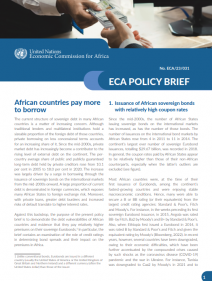The current structure of sovereign debt in many African countries is a matter of increasing concern. Although traditional lenders and multilateral institutions hold a sizeable proportion of the foreign debt of those countries, private borrowing on less concessional terms accounts for an increasing share of it. Since the mid-2000s, private market debt has increasingly become a contributor to the rising level of external debt on the continent. The per country average share of public and publicly guaranteed long-term debt held by private creditors rose from 10.1 per cent in 2005 to 18.0 per cent in 2020. The increase was largely driven by a surge in borrowing through the issuance of sovereign bonds on the international markets from the mid-2000s onward. A large proportion of current debt is denominated in foreign currencies, which exposes many African States to foreign exchange risk. Moreover, with private loans, greater debt burdens and increased risks of default translate to higher interest rates. Against this backdrop, the purpose of the present policy brief is to demonstrate the debt vulnerabilities of African countries and evidence that they pay relatively higher premiums on their sovereign Eurobonds. In particular, the brief contains an examination of the role of credit ratings in determining bond spreads and their impact on the premiums in Africa.
Share this:
Release Date:
2 August, 2023
© United Nations Economic Commission for Africa

